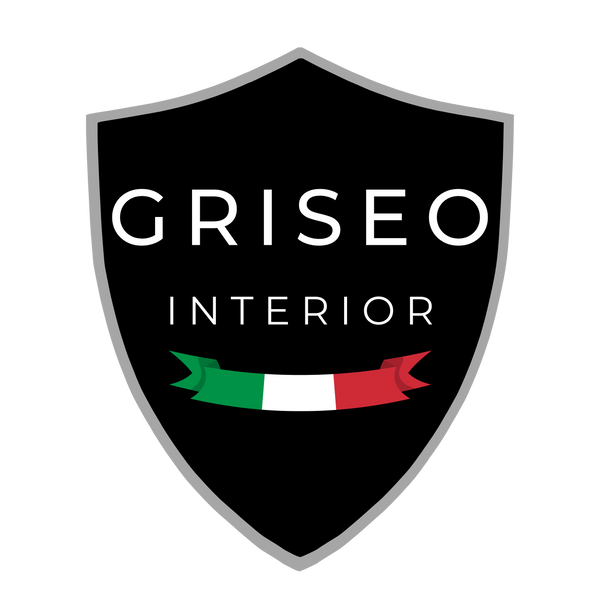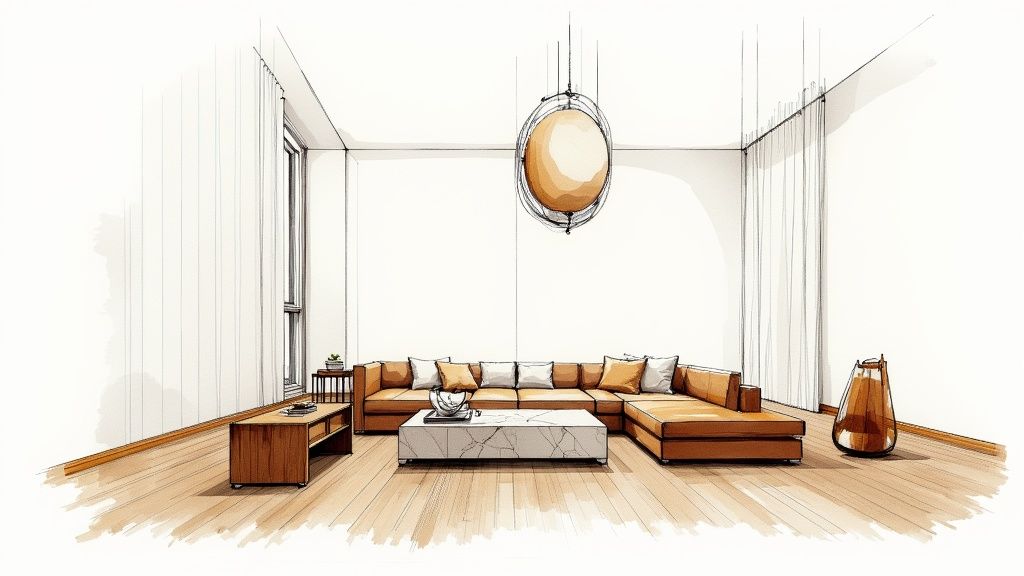
A Practical Guide to Italian Contemporary Interior Design
Picture your home as a perfectly tailored suit. It's not just about looking good; it's about the feel of the finest materials, the precision of the cut, and an elegance that seems completely effortless. This is the very soul of Italian contemporary interior design. This guide provides actionable steps to move beyond inspiration and start creating a space that marries minimalist clarity with a legacy of craftsmanship.
What Defines the Italian Design Philosophy
Italian contemporary design is, at its heart, a celebration of functional beauty. Every single line, texture, and form has a purpose. To apply this, adopt a "quality over quantity" mindset. Before adding any item to a room, ask: "Is this both beautiful and useful?" This simple question is the foundation for creating spaces that feel both incredibly luxurious and deeply personal.
The style is a masterclass in balance, pairing sleek, modern silhouettes with the organic warmth of natural materials. The result is a sophisticated atmosphere that truly captures the essence of 'la dolce vita'—the sweet life. The practical goal is to create a timeless sanctuary that feels both modern and enduring, not just chase fleeting trends.
At its core, this philosophy is about intentional living. Your actionable goal is to curate a space that is not only visually stunning but also enhances your daily experience, making everyday moments feel special.
A Legacy of Craftsmanship and Quality
The world's love affair with Italian design isn't just about aesthetics; it's a major economic force. The Italian interior design market was valued at around USD 3,736.86 million in 2023 and is set to grow even more, cementing Italy's role as a global design leader. You can dive deeper into the market's data and trends to understand Italy's design leadership.
This growth is fueled by a profound respect for authentic artisanship. When you select pieces for an Italian-inspired interior, you're not just buying an object; you're investing in a legacy of quality. Your actionable step is to choose items made to last, destined to become part of your home’s story for generations.
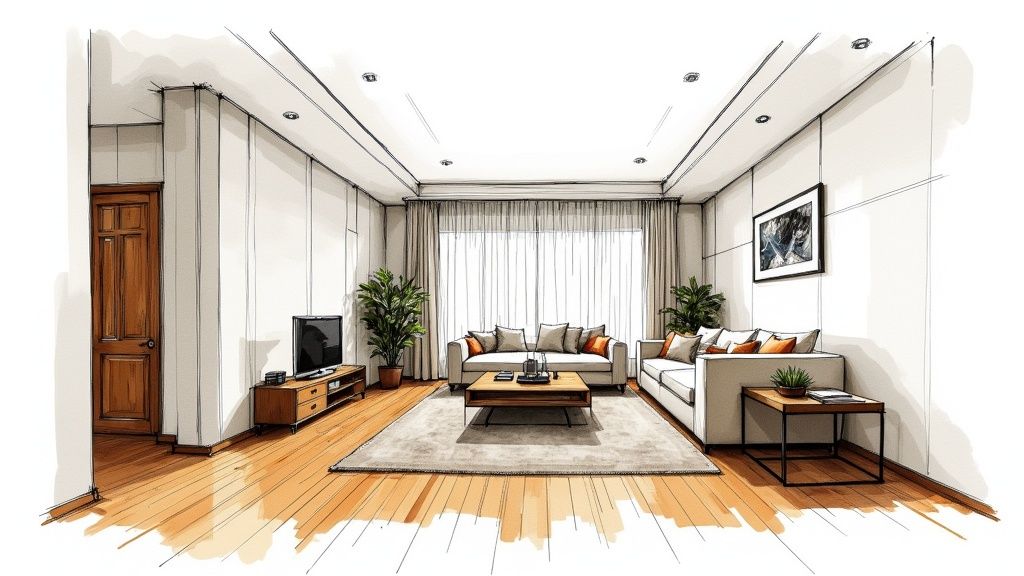
Key Principles to Embrace
To bring this spirit into your own home, focus on applying these foundational ideas. They are the practical building blocks for achieving the aesthetic.
- Mindful Minimalism: Make every piece earn its place. Before you buy something new, consider what it adds. The goal isn't an empty room but a sense of visual calm where every item has a clear purpose.
- Material Honesty: Choose materials that speak for themselves. Opt for solid wood over veneer, natural stone over synthetics, and genuine leather over faux alternatives. Let the raw beauty of the material be the main feature.
- Sculptural Forms: Treat your furniture and decor as functional art. Select a chair, table, or light fixture with a unique silhouette to serve as a powerful focal point, adding character and soul to the space.
The Unmistakable Hallmarks of Italian Style
Italian contemporary design isn’t just a look; it’s a language. It speaks of quiet elegance, told through a careful conversation between materials, shapes, and color. The practical application of this is creating an atmosphere that feels both intentionally designed and effortlessly comfortable, where every single piece plays a part in a story of sophisticated calm.
To do this effectively, start by mastering its core components.
A Deep Love for Authentic Materials
At its very heart, this style is built on a reverent appreciation for high-quality, authentic materials. To implement this, prioritize investing in pieces made from natural elements.
Imagine the swirling, natural veins in a slab of marble, the deep, rich grain of solid wood, or the soft, supple feel of genuine leather. Don't treat these as mere components; feature them as works of art. These materials carry a history and a tactile warmth that no imitation could ever hope to capture.
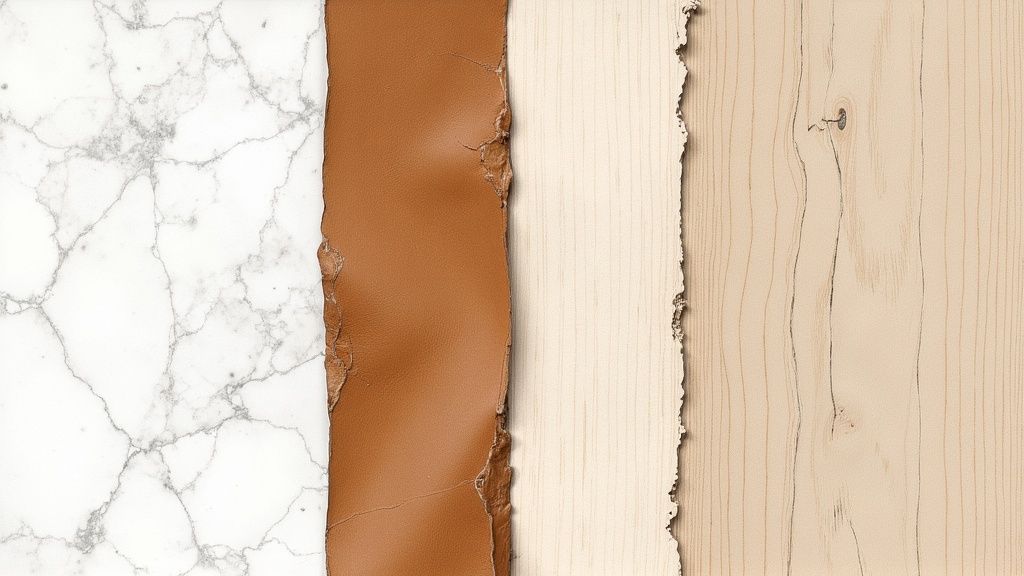
Celebrating Clean Lines and Open Space
This respect for materials is best showcased within a framework of clean lines and uncluttered spaces. Your primary action here is elegant reduction. Systematically strip away visual noise and excess decor, leaving behind a serene, sophisticated backdrop for life itself.
This is why open-plan living is so central to the style. It allows light to dance across the room, giving each carefully selected piece of furniture the space it needs to truly breathe and be appreciated. Don't mistake this for cold, stark minimalism. It’s a deliberate, purposeful approach that fosters a sense of order and tranquility—a beautiful canvas for living.
The Power of a Neutral Palette
So, how do you ensure the beautiful materials and striking forms get the spotlight they deserve? You set the stage with a neutral color palette. This isn’t a safe or boring choice; it’s a brilliant strategy. Here’s how to apply it:
- Creamy Whites: Use them on your largest surfaces, like walls, to create an immediate sense of airiness and make spaces feel expansive and bright.
- Soft Greys: Incorporate these tones through textiles or a feature piece of furniture to add a layer of modern sophistication.
- Earthy Beiges and Taupes: Introduce these colors with wood flooring, a wool rug, or linen curtains to ground the space and make it feel instantly inviting.
This quiet backdrop allows a few sculptural statement pieces—a vibrant armchair, a stunning work of art, or a lamp with a dramatic silhouette—to truly command attention without ever feeling loud or overwhelming.
The core idea is simple: in a quiet room, a beautiful object can truly sing. Use a neutral palette to ensure the focus remains on craftsmanship, texture, and form.
For a quick overview, this table breaks down the essential components that define the aesthetic.
Core Elements of Italian Contemporary Design
| Element | Description | Example in Practice |
|---|---|---|
| Authentic Materials | A focus on natural, high-quality materials like marble, solid wood, and genuine leather. | A solid oak dining table paired with a marble-topped console. |
| Clean Lines | Uncluttered, simple geometric forms in furniture and architecture. | A sofa with a low, linear profile and no fussy details. |
| Neutral Palette | A base of whites, greys, and beiges to create a serene, sophisticated backdrop. | Walls painted in a soft taupe, allowing a piece of art to be the focal point. |
| Open Space | An emphasis on airy, open-plan layouts that allow for light and movement. | A combined living and dining area with minimal visual obstructions. |
| Form & Function | A belief that every object must be as beautiful as it is practical. | A sculptural floor lamp that provides perfect reading light. |
This table serves as a simple guide, but the real magic happens when these elements come together.
A Duality of Texture and Form
The true genius of italian contemporary interior design is how it balances sleek, minimalist lines with bold, expressive textures. To achieve this, contrast materials. For example, pair a plush velvet sofa with a sleek marble coffee table. This renewed focus on classic, luxurious materials is often set against the clean, industrial feel of chrome and stainless steel—a perfect example of Italy's mastery in combining heritage with modern innovation. You can see more on how tradition meets innovation in these evolving Italian furniture trends.
Above all, there's a seamless marriage of form and function. This is your non-negotiable principle: every object must be as useful as it is beautiful. A chair is never just a chair; it's a piece of sculpture you can sit on. A table isn't just a surface; it's the architectural anchor of the room. This philosophy guarantees your space is not just a showroom, but a breathtakingly functional environment designed for living well.
How a Legacy of Innovation Shapes Today's Homes
To truly get to the heart of Italian contemporary design, you can't just look at what's happening now. You have to rewind the clock to its brilliant, rebellious past. This style wasn't born overnight; it was forged in the creative fires of post-war Italy, a time of incredible cultural and industrial energy that sparked a design revolution.
Icons like Gio Ponti, Achille Castiglioni, and Marco Zanuso were the trailblazers. They boldly turned their backs on the heavy, ornate traditions that came before them, driven by an almost obsessive desire to invent a new way of living. Their vision was lighter, smarter, and deeply connected to the human experience. They weren't just making furniture; they were sculpting a new future.
This audacious spirit opened the door to wild experiments with new materials and forms. Designers fell in love with industrial materials like molded plastics, sleek steel, and bent plywood, shaping them into objects of stunning, unexpected beauty. It was this fearless, hands-on approach that laid the groundwork for the clean, sculptural aesthetic we recognize today.
From Radical Thinking to Modern Living
You can draw a straight, unbroken line from that legacy of radical thinking to the innovative designs we see in homes right now. Contemporary Italian designers are the keepers of this flame, constantly pushing the envelope while staying true to the core principles of craftsmanship and quality their predecessors established.
This is exactly why Italian design isn't some fleeting trend—it’s a living, breathing tradition that's always evolving. It has this incredible knack for feeling both completely timeless and perfectly of-the-moment, honoring its rich past while restlessly searching for what’s next.
This enduring spirit is all about the dance between old-world artisanry and new technology. It’s a philosophy that champions using every tool available to create objects with lasting beauty and purpose—the very essence of the 'Made in Italy' promise.
Technology as the New Artisan's Tool
Today, that same innovative spirit is alive and well, just with a different set of tools. Where the mid-century masters experimented with plastics, today's artisans are exploring advanced manufacturing to create forms once thought impossible.
This fusion of past and future is everything. It's about using modern methods to express timeless design ideals. This approach gives us unbelievable precision and the ability to customize, resulting in pieces that are not just beautiful, but deeply personal.
In fact, you can see this legacy in action by exploring how 3D-printed home decor is continuing this great Italian tradition. It’s a perfect modern example of blending groundbreaking technology with an artist’s vision to shape the homes we live in today.
Choosing Your Signature Italian Furniture
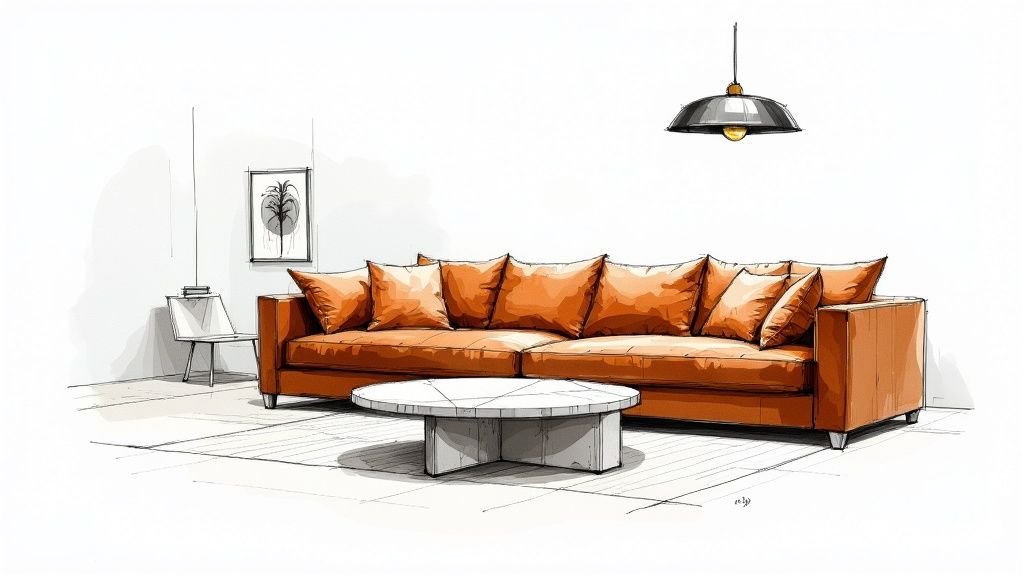
Now, let's bring these beautiful Italian design principles to life. The soul of any contemporary Italian space is found in its furniture. Your key action here is to adopt a ‘quality over quantity’ purchasing strategy. Forget filling a room for the sake of it. The Italian way is to choose a few breathtaking, foundational pieces that command attention and define the entire atmosphere.
Think of it like casting the lead actor in a film. These signature items aren't just there to serve a purpose; they are sculptural, powerful, and crafted to be cherished for a lifetime. They are the anchors of your design.
Identifying Iconic Cornerstone Pieces
The first step is to see furniture differently—not just as functional objects, but as a presence in the room. A true signature piece feels like art. It’s the item you build everything else around.
So, what should you look for? Here are a few classic examples to guide your search:
- The Sculptural Sofa: Look for a sofa with a sleek, low-slung profile and impeccable tailoring. Prioritize high-quality upholstery, like genuine leather with flawless, almost invisible stitching, for the ultimate in understated luxury.
- The Statement Coffee Table: Choose a coffee table made from a single, substantial material like a block of dramatic marble. Its natural, unique veining and solid form can ground an entire living area.
- The Artisanal Light Fixture: Select an artfully designed pendant light or floor lamp that acts as a focal point even when turned off. It should do more than illuminate; it should sculpt the light and set the mood.
Ultimately, choosing your signature piece is a personal journey. The goal, however, is always the same: find something with timeless appeal that feels both completely modern and built to endure. Even in a smaller space, one incredible piece can have an outsized impact. If you're working with a cozier layout, our guide on small living room design ideas is packed with practical tips on this very principle.
Recognizing True 'Made in Italy' Craftsmanship
The ‘Made in Italy’ label is more than a tag; it’s a promise of design integrity and craftsmanship. To spot the real thing, you must learn to look at the details.
When you invest in authentic Italian furniture, you are acquiring more than an object. You are becoming a custodian of a rich legacy of artisanship, a story of materials and skill passed down through generations.
Authentic Italian pieces shout their quality in the quietest ways. Look closer. Examine the joinery, feel the substantial weight of the materials, and run your hand over a flawless finish. This unwavering dedication to excellence is why the Italian home furniture market is projected to reach an incredible USD 17.64 billion by 2025, with icons like B&B Italia and Poltrona Frau continuing to define what quality means to the world.
This heritage is what transforms a simple piece of furniture into a future heirloom.
Bringing The Italian Look Into Your Home
Ready to invite the soul of Italian contemporary design into your own space? This is not about a radical renovation, but a journey of making deliberate, thoughtful choices. The process is straightforward: create a serene canvas where incredible quality and breathtaking form can truly sing. It starts not with furniture, but with the room’s foundation—its light and color.
Establish Your Sophisticated Foundation
Your first move is to craft an environment that feels open, airy, and impossibly calm. You get there by mastering two fundamental elements: a gentle, neutral color palette and an abundance of natural light. Imagine you're preparing a gallery for a masterpiece exhibition; the goal is a beautiful backdrop that enhances, rather than competes with, the art you'll place within it.
Next, practice strategic minimalism. This isn't about getting rid of everything you own. It’s about decluttering with purpose, asking yourself what each object truly brings to the room's story. When you clear away the excess, you give your most cherished design elements the visual space they need to breathe and be admired. This simple act creates an incredible sense of order and intention.
This infographic captures the core process perfectly, showing how an Italian-inspired interior is built.
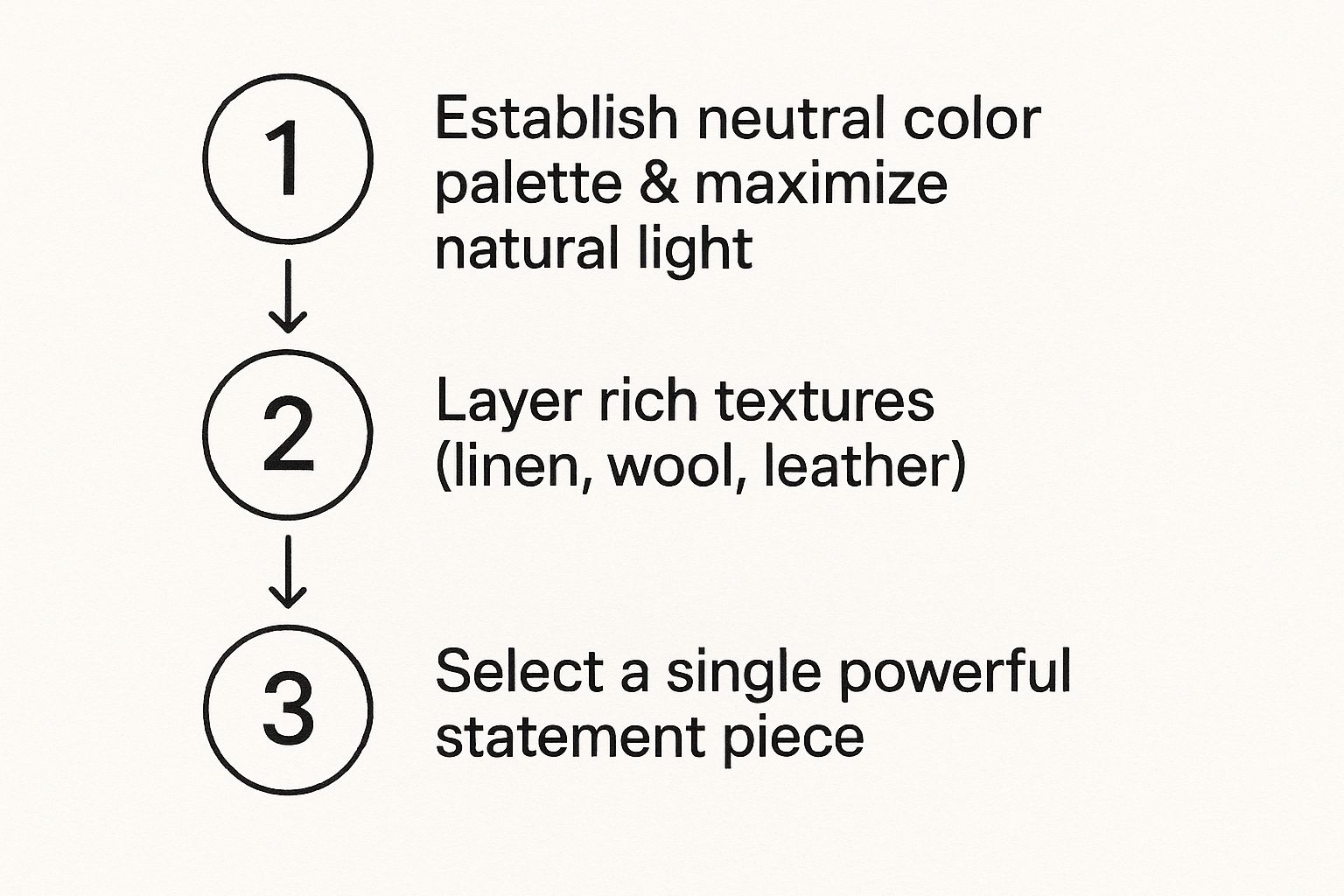
As you can see, a truly successful design is layered. It builds from the ground up, starting with that foundation of light and color before you even think about introducing rich textures or a stunning focal point.
Layer Rich Textures For Warmth
With your serene foundation in place, it’s time to bring in sensory depth and warmth through texture. This is the secret to making sure your minimalist space feels inviting and livable, not cold or stark. Here are specific textures to incorporate:
- Linen and Wool: Introduce these natural fabrics through plush throws, cushions, or your sofa's upholstery. They add a soft, tactile quality that encourages relaxation.
- Leather and Suede: A single, beautifully crafted leather armchair or a suede ottoman can introduce a rich, smooth texture that only gets better with age, adding character.
- Stone and Metal: Contrast softer elements with the cool, smooth touch of a marble tray on a coffee table or the clean lines of a brushed metal lamp.
This interplay of different materials is what creates a dynamic yet harmonious environment that truly engages all the senses.
Select Your Anchor Piece and Accessorize
Now for the most exciting part: choosing the anchor for your room. Every great Italian contemporary interior has a single, powerful statement piece that acts as its heart and soul. This might be a sculptural sofa, a dramatic dining table, or a piece of art that stops you in your tracks.
Choose an item you absolutely love—one that embodies both impeccable craftsmanship and timeless design. This piece will set the tone for the entire space.
Finally, master intentional accessorizing. Resist the urge to fill every empty surface. Instead, choose just a few select pieces of art, sculpture, or minimalist decor from Griseo Interior to add personality without creating clutter. For instance, a large, leaning mirror can be both a functional object and a sculptural element, amplifying light and making the room feel more expansive. To dive deeper, explore our guide on styling with floor-leaning mirrors and master this elegant technique.
To help you get started, we've put together a simple checklist to guide your decisions.
Bringing Italian Design Home: A Practical Checklist
This checklist breaks down the process into actionable steps, helping you apply these principles to your own home with confidence.
| Action Step | Key Objective | Pro Tip |
|---|---|---|
| Assess Your Light | Maximize natural light to create an airy, open feel. | Use sheer curtains instead of heavy drapes. Clean windows can make a 10% to 20% difference in brightness. |
| Choose a Neutral Palette | Create a serene, gallery-like backdrop for your furniture. | Stick to shades of white, cream, beige, or soft grey. Use a 60-30-10 color rule for balance. |
| Declutter with Purpose | Remove anything that doesn't serve a function or bring you joy. | Ask yourself: "Does this piece tell a part of my story?" If not, it's just visual noise. |
| Select an Anchor Piece | Establish a clear focal point that defines the room's character. | Invest in one high-quality, beautifully designed item you'll love for years. This is your centerpiece. |
| Layer with Texture | Add warmth and sensory depth to prevent a sterile look. | Mix materials: a wool rug, a leather chair, a linen throw, and a metal lamp all in one room. |
| Accessorize Minimally | Add personality without creating clutter. | Choose 3 to 5 high-impact accessories, like a vase, a sculpture, or a stunning mirror. |
By following these steps, you're not just decorating; you're curating a living space that reflects sophistication, calm, and a deep appreciation for timeless beauty.
Your Questions on Italian Contemporary Design, Answered
Diving into the world of Italian contemporary interior design is exciting, but it's natural to have a few questions as you start picturing it in your own home. Here are practical answers to give you the confidence to bring this beautiful aesthetic to life.
Modern vs. Contemporary: What’s the Real Difference?
This is a common point of confusion. Here’s the simple distinction:
Modern design refers to a specific historical style from the mid-20th century (think Mad Men). It is a completed design movement with a fixed set of characteristics.
Contemporary design, on the other hand, is the design of right now. It is what's happening in this very moment—fluid, always evolving, and free from the strict rules of any single era. Italian contemporary design borrows the clean lines of its modern predecessors but remixes them with today’s materials and technologies.
How Can Minimalism Feel So Warm and Inviting?
Many people worry that a minimalist space will feel cold, but the Italian approach prevents this. The secret isn’t about having less; it's about curating more thoughtfully. Here is how to create warmth:
- Bring in Rich Textures: Introduce materials that beg to be touched. Use a plush wool rug, a soft linen throw, or velvet cushions to add instant comfort and visual depth.
- Play with Light: Avoid a single, harsh overhead light. Instead, layer your lighting. Use a sculptural floor lamp for a soft, ambient glow and add a focused task light over a chair to create a cozy reading nook. Warm pools of light make any room feel more intimate.
The action plan is to create a calm, uncluttered canvas and then intentionally add layers of comfort. This beautiful balance is what turns a minimalist room into a true sanctuary.
Is This Style a Good Fit for Small Spaces?
Absolutely! The principles of Italian contemporary design are a small space's best friend. The style’s focus on clean lines, clear surfaces, and a light, neutral palette work together to create an illusion of space.
By following the "less but better" philosophy, you avoid cramming a room with clutter. A single, exquisitely crafted sofa and a simple, elegant coffee table will make a much bigger and better impression than a dozen smaller, less impactful items. The goal is to make your space feel open, airy, and intentional, no matter its size.
How Do I Find Authentic Italian Furniture?
When you invest in a piece that's genuinely 'Made in Italy,' you're not just buying furniture; you're buying a piece of art and a legacy of quality. To ensure you’re getting the real deal, follow these steps:
Start by researching established brands known for their design heritage. Seek out retailers or galleries that specialize in Italian furniture and can tell you the story behind each piece. When you see something in person, let your hands be your guide. Feel the quality of the materials, admire the precision of the joints, and look for a flawless finish. These are the quiet hallmarks of true craftsmanship.
At Griseo Interior, we honor this incredible legacy by blending timeless Italian artisanship with a modern sensibility. Every one of our décor pieces is created on demand, specifically for you, forging a personal connection between you and authentic design.
Ready to bring a piece of Italy home? Explore our collection at Griseo Interior and start your journey.
